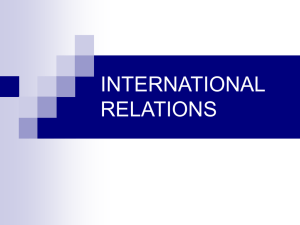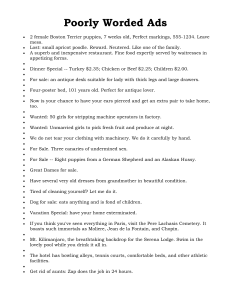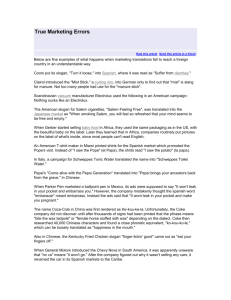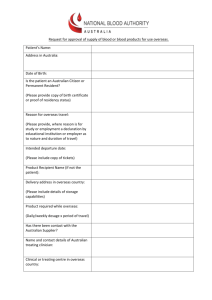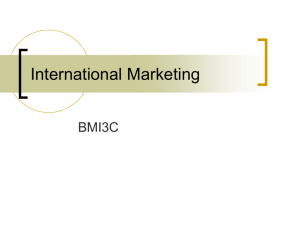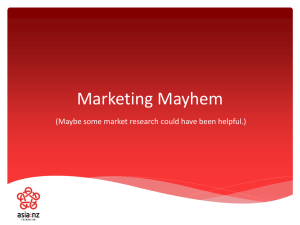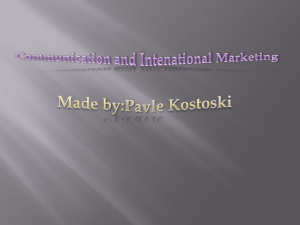4.7 - International Marketing KGLx
advertisement
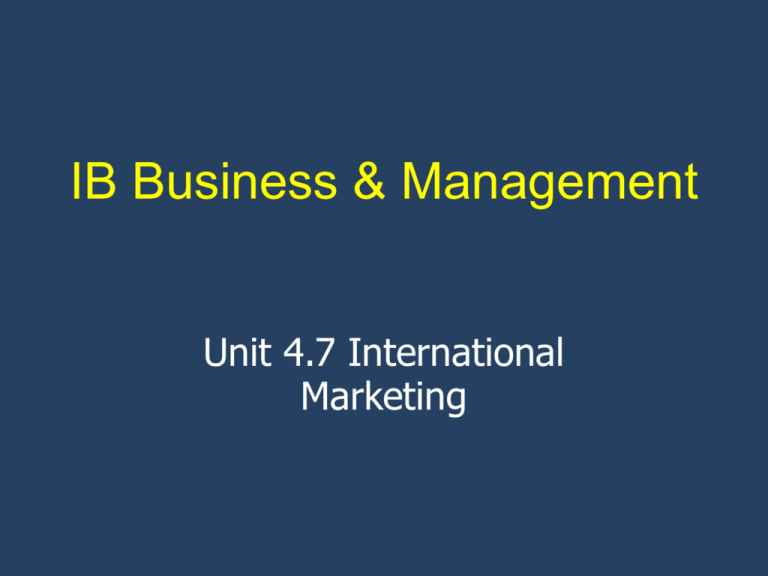
IB Business & Management Unit 4.7 International Marketing LOOK AT THESE INTERNATIONAL BRANDS THAT ARE MARKETED UNDER DIFFERENT BRAND NAMES INTERNATIONALLY International Marketing • The marketing mix for the product may have to be adapted • This can be called ‘glocalisation’ Task – Glocalisation at McDonalds • Each person in the group picks 2 countries and visits the appropriate McDonalds Website. • Identify any products you think are made specifically for the local market in this country • Create an A3 poster. • The title ‘McDonalds in _________’ • Include images of the products and the names of them underneath • Include a border • Include the McDonalds Logo (top left corner) • Include a country flag (bottom right corner) Ansoffs matrix (HL only) Ansoffs Matrix and International Trade • Entry into overseas markets represents market development. • Existing products are sold in new markets. • It is appealing because: • - market penetration is difficult in saturated markets. - product development is costly. - diversification is risky Why Enter International Markets? • Why do firms decide to sell their products abroad? • The reasons for entering overseas markets can be categorised into “push” and “pull” factors: Push factors • Saturation in domestic markets • Economic difficulty in domestic markets • Near the end of the product life cycle at home • Excess capacity • Risk diversification Pull factors • • • • • • The attraction of overseas markets Increase sales Enjoy greater economies of scale Extend the product life cycle Exploit a competitive advantage Personal ambition CHOOSING INTERNATIONAL MARKETS – WHAT FACTORS SHOULD FIRMS CONSIDER? WHERE? • Consumer behaviour? • Cultural influences? • Demographic trends? • Distance/transport costs? • Economic trends? • Market size? • Availability of agents? • Competition? • Infrastructure? • Trade barriers? • Skills/technology base of host country? • Labour/land costs How to Enter International Markets: • Exporting o Sell products directly to overseas buyer • Direct Investment o Setting up facilities in a foreign country • E-Commerce o Sell via the internet • Joint Ventures o Two companies pool resources and create a 3rd company How to Enter International Markets: • Strategic Alliances Businesses pool human, capital & financial resources in a shared project o Do not form new business o • Franchise • Licensing o Allow foreign country to produce/market your product • Mergers o Two become one o Buy another company • Acquisition/Takeover Task • Get in groups of 3 • Discuss issues companies may face in doing business overseas • List as many potential problems as you can • Now separate these into PEST factors PEST FACTORS REGARDING INTERNATIONAL TRADE Issues & Problems: Legal • Copyright & patent protection differ o o Inventions Ideas, logos, slogans, etc. o Advertising o Many countries pushing for ban on junk food advertising • Consumer protection laws differ Children Weapons Smoking & Drinking Issues & Problems: Political • Trade barriers • o o o o o Quotas Tariffs Embargoes Regulation, licenses, visas Subsidies o Visas etc Administrative barriers Issues & Problems: Social & Demographics • • • • • • Different Culture Multicultural nations Differing consumer tastes Internet uptakes Average age within nation Incomes vary within & among countries • Pressure Groups o Language Language barriers - examples •In Taiwan, the translation of the Pepsi slogan "Come alive with the Pepsi Generation" came out as "Pepsi will bring your ancestors back from the dead." •Also in Chinese, the Kentucky Fried Chicken slogan "finger-lickin' good" came out as "eat your fingers off." •When General Motors introduced the Chevy Nova in South America, it was apparently unaware that "no va" means "it won't go." After the company figured out why it wasn't selling any cars, it renamed the car in its Spanish markets to the Caribe. •When Parker Pen marketed a ballpoint pen in Mexico, its ads were supposed to say "It won't leak in your pocket and embarrass you." However, the company mistakenly thought the spanish word "embarazar" meant embarrass. Instead the ads said that "It wont leak in your pocket and make you pregnant." •In Italy, a campaign for Schweppes Tonic Water translated the name into Schweppes Toilet Water. Issues & Problems: Economic • Things to watch out for: o Transportation costs o Longer Supply Chains o Communications costs o Interest rates o Exchange rate fluctuations International Marketing Mix How would the marketing mix of the following products have to be adapted for different markets Price Product Place Promotion Physical Evidence • Processes • People • Packaging • • • • • Task • Pick an international product • Outline how the marketing mix has been/would have to be adapted for the market in China • Refer to as many of the elements of the marketing mix as appropriate • Evaluate- To what extent has/would the marketing mix have to be adapted? • Present your ideas to the rest of the group Task • IB Question • 25 minutes
